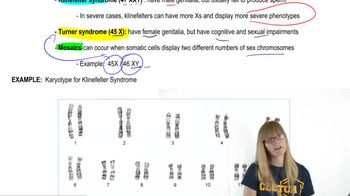If one is constructing a phylogeny of reptiles using DNA sequence data, which taxon (birds, mammals, amphibians, or fish) might be suitable to use as an outgroup?
Table of contents
- 1. Introduction to Genetics51m
- 2. Mendel's Laws of Inheritance3h 37m
- 3. Extensions to Mendelian Inheritance2h 41m
- 4. Genetic Mapping and Linkage2h 28m
- 5. Genetics of Bacteria and Viruses1h 21m
- 6. Chromosomal Variation1h 48m
- 7. DNA and Chromosome Structure56m
- 8. DNA Replication1h 10m
- 9. Mitosis and Meiosis1h 34m
- 10. Transcription1h 0m
- 11. Translation58m
- 12. Gene Regulation in Prokaryotes1h 19m
- 13. Gene Regulation in Eukaryotes44m
- 14. Genetic Control of Development44m
- 15. Genomes and Genomics1h 50m
- 16. Transposable Elements47m
- 17. Mutation, Repair, and Recombination1h 6m
- 18. Molecular Genetic Tools19m
- 19. Cancer Genetics29m
- 20. Quantitative Genetics1h 26m
- 21. Population Genetics50m
- 22. Evolutionary Genetics29m
22. Evolutionary Genetics
Phylogenetic Trees
Problem D.1
Textbook Question
Why might mitochondrial, Y chromosome, and autosomal DNA provide different perspectives on our evolutionary past, for example, with respect to our relationship with Neanderthals?
 Verified step by step guidance
Verified step by step guidance1
Understand that mitochondrial DNA (mtDNA), Y chromosome DNA, and autosomal DNA are inherited differently: mtDNA is maternally inherited, Y chromosome DNA is paternally inherited, and autosomal DNA is inherited from both parents.
Recognize that because mtDNA and Y chromosome DNA do not undergo recombination (or very little), they trace direct maternal and paternal lineages respectively, providing a more linear and specific ancestral path.
Note that autosomal DNA recombines every generation, mixing genetic material from all ancestors, which offers a broader and more complex picture of ancestry and gene flow, including interbreeding events.
Consider that differences in inheritance patterns mean mtDNA and Y chromosome analyses might miss some gene flow events that autosomal DNA can detect, such as interbreeding between modern humans and Neandertals.
Conclude that these different types of DNA provide complementary perspectives: mtDNA and Y chromosome DNA highlight direct maternal and paternal lineages, while autosomal DNA reveals the overall genetic contributions from multiple ancestors, including admixture with Neandertals.
 Verified video answer for a similar problem:
Verified video answer for a similar problem:This video solution was recommended by our tutors as helpful for the problem above
Video duration:
2mPlay a video:
Was this helpful?
Key Concepts
Here are the essential concepts you must grasp in order to answer the question correctly.
Mitochondrial DNA Inheritance
Mitochondrial DNA (mtDNA) is inherited exclusively from the mother and does not recombine, providing a direct maternal lineage. This makes mtDNA useful for tracing maternal ancestry and evolutionary history, but it represents only a small fraction of the genome and one lineage path.
Recommended video:
Guided course

Organelle Inheritance
Y Chromosome Inheritance
The Y chromosome is passed from father to son and also does not undergo recombination over most of its length. It traces paternal lineage, offering insights into male-specific ancestry and population history, which can differ from maternal or autosomal perspectives.
Recommended video:
Guided course

Human Sex Chromosomes
Autosomal DNA and Recombination
Autosomal DNA is inherited from both parents and undergoes recombination each generation, mixing genetic material from many ancestors. This provides a more comprehensive and complex picture of ancestry and evolutionary relationships, including admixture events like interbreeding with Neandertals.
Recommended video:
Guided course

Recombination after Single Strand Breaks
Related Videos
Related Practice
Textbook Question
583
views


